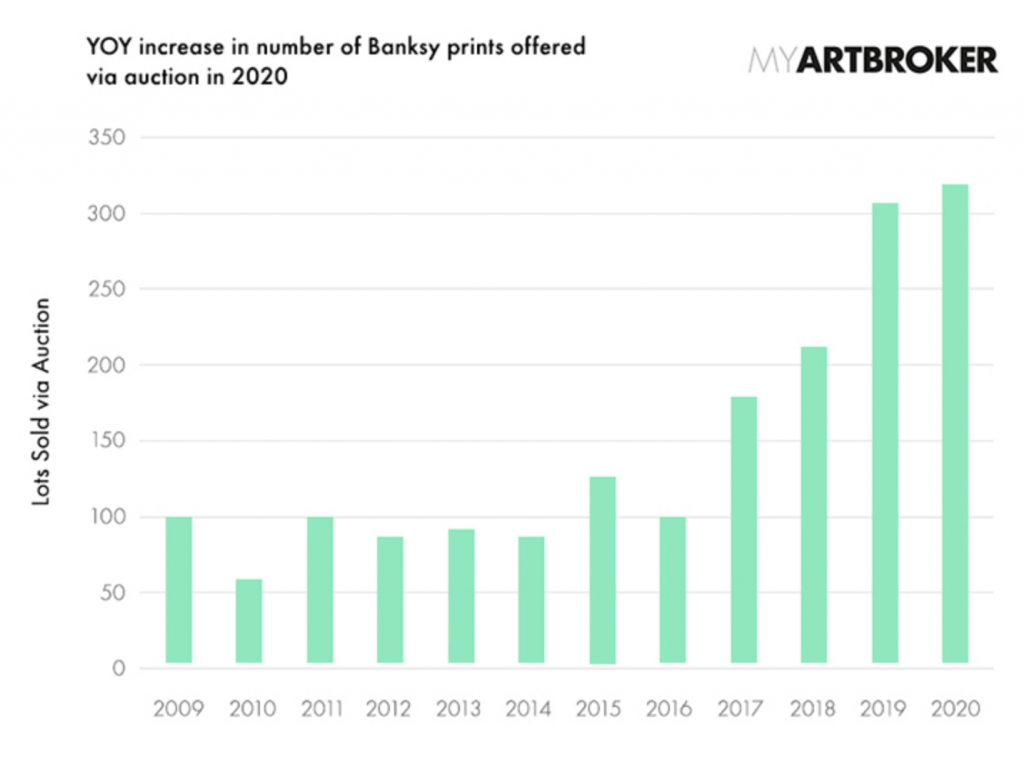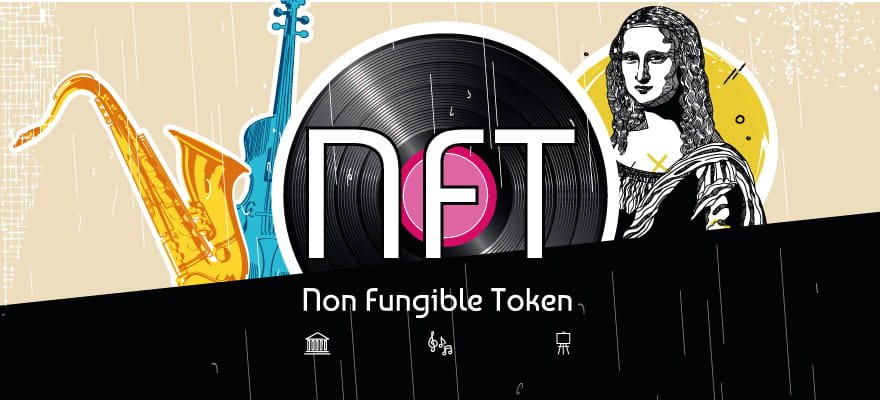NFTs certainly are not a new concept. Most of the cryptocurrency world has been at least nominally aware of them since the CryptoKitties craze jammed up the Ethereum Blockchain in late 2017. Since then, the NFT space has quietly been building itself. However, to most folks outside of the crypto space NFTs may have seemed to appear out of nowhere when celebrity artists and musicians suddenly began making a killing off of them earlier this month.
The concept is fairly simple: try to imagine owning 0.001 of the Mona Lisa. This is exactly what NFTs allow art collectors and appreciators to do, and artists are already taking advantage of the trend, bigtime.
The list is quite impressive: Canada-based Grimes (aka Claire Boucher), made nearly $6 million in an auction of several digital pieces she sold on NFT platform NIfty Gateway. A digital artist known as 'Beeple' sold a single NFT video for $6.6 million, also on Nifty Gateway; a token tied to an incinerated Banksy painting fetched $380K on OpenSea, another NFT marketplace.
The list of NFT issuers in the music world is growing. Latin-trap sensation 'Ozuna' recently made $800,000 on an NFT sale. Kings of Leon has plans to get in on the NFT action with a 'tokenized album' that was released earlier this month; so far, the album has earned about $2 million. DJ Deadmau5 launched $100,000 worth of NFT collectibles in December of 2020.
American DJ '3LAU' also collected a record-breaking $11.6 million in exchange for 33 non-fungible tokens related to the third anniversary of his Ultraviolet album. According to Digital Music News, the NFTS included things like “a custom song, access to never-before-heard music, and custom art. The NFTs included a limited edition pressed vinyl of Ultraviolet’s 11 original songs.”
As big as these sales have been, many analysts are saying that what has happened so far is just the tip of the iceberg.
What Is an NFT?
If you are wondering what the hell an NFT actually is, here is what you need to know.
Jason Deane at Quantum Economics explained to Finance Magnates that: "while the concept of NFTs has been around for a while, it is only recently that their presence has really become obvious."
"This is partly to do with the fact that new concepts take time to develop real momentum, the ecosystem supporting them was (and still is) very much under development and, of course, there have been a few high profile transactions that have bought attention to the whole concept."
"There appears to be a lot of chatter about NFTs in certain parts of the art world, ranging from 'minimal long term impact' to 'complete disruption'. The truth may well settle somewhere in-between and it is certainly too early to say. In theory, and recently in practice, there is clear evidence to say that artists who have adopted this new media have much more direct access to the market through the 24/7 global digital delivery platform of the internet, effectively digital art for a digital age," Deane. said. "For the first time, art lovers can buy and own a guaranteed digital original that can be easily verified."
Here is how it works on the technical end: NFTs are a kind of cryptographic token that have some similarities with Cryptocurrencies like Bitcoin. Like BTC, non-fungible tokens are issued on a blockchain and are transacted through blockchain networks.

Quantum Economics' Jason Deane.
However, unlike Bitcoin and other cryptocurrencies, NFTs cannot be interchangeably exchanged. Each one is digitally unique. One NFT will never be exactly equal to another NFT, similar to the way that Van Gogh painting or a Frank Lloyd Wright house cannot be interchangeably exchanged for another Van Gogh or another Frank Lloyd Wright home.
This uniqueness is what makes them 'non-fungible'. Assets like BTC, Ether (ETH), or even the good ol’ USD, are fungible: a $1 bill can always be exchanged for another $1 bill, even if the two bills have some differences in their physical characteristics. Similarly, 1 BTC will always be equal to another BTC, even if they have different transactional histories and were mined at different times.
Because NFTs are digitally unique, each one can be imbued with a specific work of music, art, comedy, sports video, Tweet or just about anything you can think of. The creators issuing the tokens can set the terms of whether or not NFT ownership of a particular work translates to the ownership of the intellectual property of that work.
NFTs Could Be a "Win-Win" for Artists Who Struggle to Get Paid for Their Work
So far, the practice of NFT issuance has largely been described as a new way for dedicated fans to interact with and support their favourite creators. And, non-fungible token issuance certainly is that, but NFTs could be something much more vital to the arts. They could be a new and powerful way for creators to earn a living.
Gunther Sonnenfeld, CEO of NFT digital rights management platform, RAIR, told Finance Magnates that: “if you talk to professional artists, they will all tell you how difficult it is to get their work into galleries and exhibitions, as well as how to get paid.”

Gunther Sonnenfeld, CEO of NFT digital rights management platform, RAIR.
Similarly, “musicians have been facing significant limitations in profitable distribution, even though the costs of production are a lot less, and you can lay down tracks in your living room or garage with sophisticated technology tools.” In other words, independent musicians could use NFTs as a way to rise above the struggle of earning fractions of a cent for each time their music is streamed.
Additionally, “aspiring creators have the more obvious challenge of leveraging their followers on social media for profit, while established creators are constantly fighting for cultural relevance,” he said. “In both cases, NFTs at once allow creators to find their relevant audiences, and provide a great mechanism for them to manage their distribution while controlling the financial pieces.”
Sonnenfeld pointed out that although NFTs have largely been discussed in relation to the millions that they have made for big stars, smaller creators would be wise to get in on the NFT game while it is a relatively new field.
“It’s a win-win for everyone, especially for smaller, independent creators whose longer tail content might not appeal to consumers at mass scale, but have great appeal to aficionados nonetheless.”
“Digital Scarcity in an Internet-Abundant World Is Being Reinvented with NFTs.”
The reason that NFTs show so much promise for artists is because of an economic mechanism that they can produce in the digital world: scarcity. Scarcity is the same mechanism that has been credited for Bitcoin’s rise as a 'hedge' against USD inflation.
Sonnenfeld explained that: “digital scarcity in an Internet-abundant world is being reinvented with NFTs.”
“If you consider that digital goods and services don’t have quite the protection and options they should with regular fungible cryptocurrencies, non-fungible tokens provide them, especially with digital rights management,” he said. “In other words, NFTs are provably unique serial numbers that can represent real value, rather than just instruments for trading and exchanging things purely on speculation.”
In other words, NFTs can provide a new way for artists to earn and even spread the wealth with their fans. Sonnenfeld gave “a simple example: If you self-publish a book or an academic paper, someone can pay for it with Bitcoin.”
“Yet, neither Bitcoin, nor any base-level blockchain, allows you or the purchaser of that book (or paper) to share it and share in the revenue seamlessly," Sonnenfeld said. In other words, after an NFT token has been purchased from the issuing creator, it can be sold in secondary marketplaces, allowing its holder to earn from their purchase. Issuing artists can set the NFT terms so that they collect a percentage every time a token is sold.
This is where the real potential for earning comes into play. If an investor can scoop some of the NFT shares fairly early in an artists' career, the turnaround down the road could be considerable. For example, data from Banksy print increased in 2020? Data from MyArtBroker.com shows that there was an 85% YOY increase in the average value of a Banksy print in 2020 alone.

In a pre-NFT universe, those prints, or any of Banksy's works, could only be owned or invested in by collectors who could afford to purchase, ship and care for entire pieces. However, through NFT issuance investors can get in on an artist's work instantly, without having to worry about any of the logistics of caring for the physical work itself. It is also possible that investors could own pieces of an NFT rather than the whole thing, a possibility that opens the culture market up to smaller investors.
However, Quantum Economics' Jason Deane explained that there could be some ethical questions that might arise around art and NFts. "Some have expressed concern that physical art has already been destroyed to guarantee the scarcity of the NFT, an action that raises any number of questions of whether value is really being added, These include whether this is a morally right thing to do, whether it increases or decreases accessibility to the intended audience and many others."
"In the end, like any potentially disruptive change, the balance between markets, artists and what people actually want will determine the outcome."
"We See NFTs as a Digital Stamp for Ensuring That Artists Are Not Taken Advantage of and a Tool for Expanding Their Impact.”
In any case, the scarcity that NFTs could create is exactly why they may be so revolutionary for the way that finances operate in the cultural sphere. “Historically, the art market is a classic example of speculated value not determined by the artists themselves,” Sonnenfeld explained. It is demand-side inflation, but with variables that typically exist outside of the artist’s purview or control.
Indeed, “if artists and creators have control over what they put into the market - specifically, through their own digital provenance (ownership) - they now have supply-side influence,” Sonnenfeld explained. “They themselves can control the number of copies or prints (traditionally known as artist prints), who they transact with, and how they get paid.”
“NFTs represent all of these functions and much more. An NFT is a unique serial number that can represent your bank, your cloud, your store of value and your unit of account all wrapped into one functioning utility.”
An artist known as theRave, a founding member of the band Spells and Curses, explained the role of scarcity in the NFT universe this way: “NFTs allow for artists to set the price for a digital art piece of their creation,” he said. “The artists set the NFT token price, as well as the level of scarcity.”

theRave, a member of the band Spells and Curses.
“By doing so, depending on how relevant and revered the artist's work stays, it becomes an appreciating asset class in the same way an original Monet painting does.”
In addition to digital art and music, NFTs could introduce scarcity to other artistic products that have not typically been treated as tradeable commodities.
For example, Christos A. Makridis, Chief Technology Officer for performing arts edtech Living Opera, told Finance Magnates that: “we are working towards building a community and platform where singers in the fine arts can issue NFTs for [the sound of] their unamplified voice.”

Christos A. Makridis, Chief Technology Officer for performing arts edtech Living Opera.
“If other pop artists or users want to use versions of that voice, the NFT would allow the artist to protect their sound and obtain licensing revenues from it. Overall, we see NFTs as a digital stamp for ensuring that artists are not taken advantage of and a tool for expanding their impact.”
The Use of NFTs Makes It Significantly More Difficult to Steal or Copy Another Creator’s Work
As such, Thomas Borrel, Chief Product Officer at security token issuance platform, Polymath, also believes that NFTs could be financially transformative for the cultural sphere, particularly for small independent creators.
“It’s not altogether surprising that major art sales have dominated the media narrative, as these big names and figures draw the most attention,” he said. “But, smaller artists and musicians can benefit from NFTs in the same way as the major players.”
Indeed, “because NFTs provide a permanent, unchangeable digital record of ownership of any given asset, the use of NFTs makes it significantly more difficult to steal or copy another creator’s work - thus ensuring smaller creators get the recognition they deserve.”
“Smaller creators will also benefit from being able to connect with their fans and better understand how to engage with them in addition to being able to profit from every transaction that’s associated with their work, guaranteeing fair compensation without needing to be associated with a more well-known name in the industry.”
“Smaller Artists Simply Need to Participate."
How do these independent creators themselves feel about NFTs?
Not everyone is a believer. Ezio Razzi, a painter, told Finance Magnates that: “NFTs are not a magical tool that's gonna make artists suddenly get rich and famous.”
“The reality is that making money with NFTs as an artist is the same as trying to make money in the physical world. You're gonna have to work hard and make a name for yourself in order to make it,” he said.
However, Living Opera’s Christos Makridis told Finance Magnates that independent creators must participate in the NFT world to explore the full potential that NFTs could have.
“Smaller artists simply need to participate,” he explained. “Even if it does not make complete sense right now, each artist should gauge on their own whether it's worth issuing NFTs and potentially make the decision to do so over their work, or perhaps part of it.”
In order to maximize this potential, Makridis explained that: “each artist should think about what parts of their audience really care about capturing the experience and essence of their artform, then focus their efforts on issuing NFTs around that experience.”
If independent artists participate in the NFT marketplace on a widespread scale, the implications for the art world could go beyond the financial realm.
“If NFTs are successful in digitally representing experience and securing ownership over creative content, then we should see much greater decentralization of artists and declines in centralized authority, such as casting directors,” Makridis said.
“These centralized authorities exist precisely because there is less of a way for artists to digitally represent and share their content, but NFTs provide a step forward on that frontier. We should see many more artists who are able to make a living and fewer centralized authority figures that dominate the space and act as ‘gatekeepers’.”
In other words: as the potential for NFts continues to unfold, the arts and cultural economy could be set for a huge explosion. Watch this space.

















